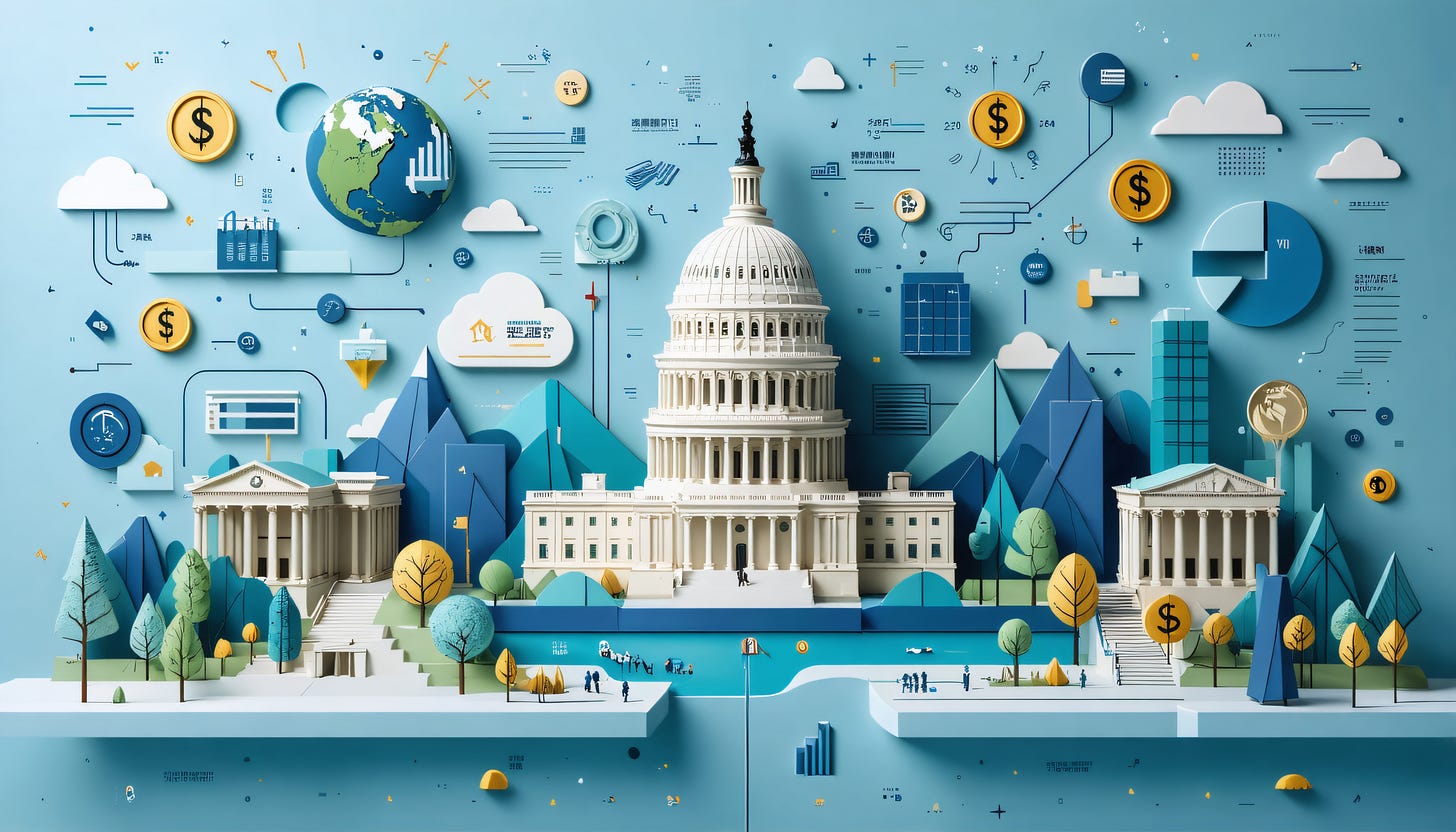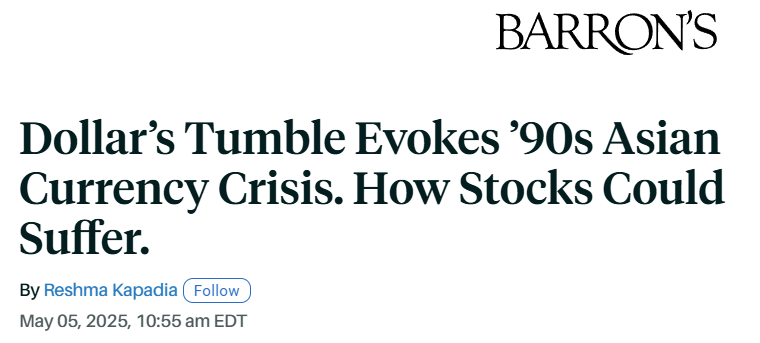Trapping Global Wealth in America: The Three-Pronged Approach
How Policy Steers Global Capital to U.S. Domestic Assets
What if the market’s chaos, such as skyrocketing Treasury yields, a wobbling dollar and stock market rollercoasters, wasn’t chaos at all? What if it’s a calculated move, with U.S. debt as the chessboard and global capital as the pawns? As tariffs reshape trade and markets in 2025, investors like you who invest in your future, face a choice: get trapped with the herd or leap to new opportunities. Let’s uncover the underlying plot behind smoke and chart your path to thrive.
Picture the U.S. economy teetering on the edge, worn by a $33 trillion debt. Tariffs, like a captain’s steady hand, are steering it back. It is a signal that Moody’s downgrading U.S. Treasuries from the world’s safest asset to 12th place. In 2008, a similar downgrade crushed Lehman Brothers, sparking a global crisis. In 2021, it sank China’s Evergrande, erasing half of homeowners’ savings. Now, in 2025, this downgrade nudges pensions, insurers, and funds to rethink U.S. bonds. This isn’t a crisis—it’s a containment, designed to lock capital in U.S. markets.
Treasury Yields: A Magnet for Investors?
Long-term Treasury yields are surging, rattling portfolios and making headlines. The Wall Street Journal reports investor fears over sovereign risk, with yields climbing as bond prices plummet. Bloomberg notes a wave of credit reassessments fueling the sell-off. If you’re holding long-term Treasuries, you’re feeling the burn. But for those with short-term bonds or cash reserves, rising yields are a golden ticket. They roll over maturing bonds into new ones at higher rates to lock in returns before rates potentially drop. The yield on the U.S. 30-year Treasury closed at 5.031% last Friday, May 23rd.
Here’s why this matters: higher yields are drawing investors, especially foreign ones, into U.S. debt. Tariffs contribute by raising import costs, which elevate inflation expectations and help justify the Fed’s tight policy stance. That same policy keeps yields elevated, which makes Treasuries attractive again. Facing limited reinvestment alternatives, they may feel compelled to purchase U.S. debts while prices are falling. What appears to be a collapse in bond value may, in hindsight, prove to be a golden entry point.
The Dollar’s Slide: Inflating Away a $33 Trillion Debt
A weaker dollar is the plan to inflate away America’s high flying debt. The 2025 budget tacks on $1.9 trillion to the $33 trillion national debt, pushing interest payments to $1.2 trillion annually. With high rates sticking around, covering just the interest is becoming a pipe dream. Tariffs are the tool: they jack up import prices, so you need more dollars for the same foreign goods, from Chinese gadgets to German cars. This slashes the dollar’s purchasing power, devaluing it against foreign currencies.
This dollar slide is tariffs’ immediate punch, not the slow dream of manufacturing reshoring, which could take years to even start. It’s a modern Plaza Accord, but far slicker. In 1985, global powers signed a deal to weaken the dollar for U.S. exports. Today, tariffs do it unilaterally, rippling across the globe without the need to sign single treaty. The real motive? By devaluing the dollar, tariffs make U.S. debt a trap foreign investors can’t escape, fueling demand for Treasuries to keep America’s debt machine humming. Here is how —
Consider Japan: tariffs curb exports to the U.S., cutting dollar receipts by Japan. A weakened demand for dollar strengthens the Yen. If the seller of US debts converts the dollar into Yen, they suffer a loss from currency exchange. Why would they do so? They are better off to reinvest in the new US debts at higher yield rates, as explained above.
Japan’s bond market is soaring, with yields spiking as investors bet on a revival after decades of stagnation. These rising bond yields push the Bank of Japan (BOJ) toward rate hikes. For Japanese funds holding U.S. bonds, a stronger Yen and falling bond prices spell double losses. To dodge collapse, they would reinvest in U.S. Treasuries directly or buying stablecoins, such as USD1 as describe in our last newsletter.
Stock Market Swings: Locking in Foreign Capital
Last year, investors borrowed cheap Yen to chase U.S. stock gains, only to get scorched in a Yen carry trade panic. This currency clash amplifies U.S. stock market swings, setting the stage for deeper turbulence. A potential second Yen carry trade crisis is not the only cause of US market correction.
Stock market volatility is a lever to trap foreign investors, especially non-U.S. giants holding U.S. equities. Tariffs and a weaker dollar amplify the chaos. Non-U.S. investors hold trillions in U.S. stocks. A crash slashes their portfolio values, and converting back to their stronger currencies (like the Yen or Euro) means massive exchange-rate losses, up to 10% in days as seen with the Taiwan dollar.
As tariffs compress corporate margins and raise import costs, earnings revisions and growth outlooks may falter. At the same time, a weakening dollar drives up input costs for multinationals, pressuring profitability. These forces may culminate in a broad equity market correction — potentially as early as Q3 2025, when corporate earnings results begin to reflect the full impact of tariffs and currency pressures. This seasonal earnings window could act as the catalyst for the third punch. A shakeout that pressures global capital to choose: take the losses and leave, or reinvest into the safer corner of the U.S. system.
Oil Jolt
Oil could be the wild card. Seasonal disruptions or conflicts might choke its supply chain, spiking crude prices and stoking inflation fears, as noted in recent market analyses. Even with eight Opec+ members agreed to start increasing crude oil output, a hurricane or Middle East flare-up could push oil higher. This would cement the Fed’s high-rate stance, boosting Treasury yields and making U.S. debt more attractive.
Oil’s like a rogue wave. It wasn’t on the radar, but it can tilt the deck at any moment.
What’s Upcoming
The 2025 unconventional shifts in tariffs, yields, dollar and stock crashes demand a new mindset. Don’t expect Federal Reserve rate cuts anytime soon; persistent nominal inflation keeps them on hold, though rising unemployment, which may worsen in the coming months, could force their hand. Look for stock market consolidation, with a deeper pullback likely around late June and July accompted by a long and winding tariff talks, or battles, with China, stretching negotiations as both sides flex muscle.
What about the June debt repayment crisis? It’s a nothingburger. The Treasury can repay a large debt maturity by the end of June by borrowing enough to cover it. The Treasury expects to borrow $514 billion in privately-held net marketable debt during the April-June quarter.
Forge Your Path
This isn’t chaos—it’s a grand plan to make U.S. debt desirable, weaken the dollar strategically, and pull global capital back to America. Tariffs, like a sculptor’s chisel, are carving a new economic era, echoing the Plaza Accord’s spirit without a single signature. When markets dip, the bold play is clear: buy low, aim high.
As tariffs reshape trade and wealth, you’re not just an investor; you’re a dreamer sowing seeds for a brighter tomorrow. With every choice, you nurture hope, like a hearth warming a home through winter’s chill. Trust your inner light, step boldly, and together, let’s craft a future radiant with possibility. You don’t need a billionaire’s bankroll—just a sharp eye for opportunity.
Go Global, Stay Nimble: Diversify into gold, Bitcoin to hedge dollar weakness.
Bet on Resilience: Defensive U.S. equities (e.g., tariff-protected sectors to weather volatility.
Track the Trends: Monitor yield curves, Treasury auctions, and market momentum, not Fed chatter.
Seek Value, Not Hype: Favor undervalued assets over pricey stocks—venture capital in U.S. startups offers big potential, as we mentioned before.
Hold Your Fire: Keep cash ready for when markets clarify, ensuring you buy the dip with confidence.
Disclaimer: This newsletter is for educational and entertainment purposes only and is not financial advice. Markets are unpredictable, and risks abound. Consult a qualified financial advisor and conduct your own research before making investment decisions.





Cool stuff